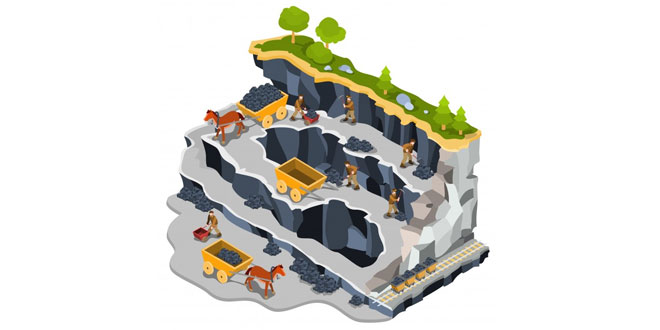NCERT 10th Class (CBSE) Social Science: Minerals and Energy Resources Quiz
32 Multiple Choice Questions related to NCERT 10th Class (CBSE) Social Science: Minerals and energy resources Quiz:
- The four manganese producing states are (1) Karnataka, (2) Orissa, (3) Madhya Pradesh, (4) Maharashtra.
- The commercial sources of energy are: Coal, Petroleum, Natural gas, Hydro-electricity and Nuclear energy.
- Non-commercial source of energy are fire wood, charcoal, cow dung and agricultural wastes, wood coal and babool wood.
- The conventional sources of energy are Coal, Petroleum, Natural gas and Electricity.
- Solar energy, wind power, bio gas and geothermal energy are non-conventional energy resources.
Your Score:
Your Ranking:
Minerals and Energy Resources Quiz Summary
Minerals
A homogeneous, naturally occurring substance with definable internal structure is called mineral.
Types of Minerals
- Metallic
- Ferrous (containing iron): Iron ore, manganese, nickel, cobalt, etc.
- Non-ferrous: Copper, lead, tin, bauxite, etc.
- Precious: Gold, silver, platinum, etc.
- Non-metallic: Mica, salt, potash, sulphur, granite, limestone, marble, sandstone, etc.
- Energy Minerals: Coal, petroleum and natural gas
Mode of occurrence of minerals:
- In igneous and metamorphic rocks: The smaller occurrences are called veins and the larger occurrences are called lodes. They are usually formed when minerals in liquid / molten and gaseous forms are forced upwards through cavities towards the earth’s surface. Examples: tin, copper, zinc, lead etc.
- In sedimentary rocks: In these rocks, minerals occur in beds or layers. Coal, iron ore, gypsum, potash salt and sodium salt are the minerals found in sedimentary rocks.
- By decomposition of surface rocks: Decomposition of surface rocks and removal of soluble constituents leaves a residual mass of weathered material which contains ores. Bauxite is formed in this way.
- As alluvial deposits: These minerals are found in sands of valley floors and the base of hills. These deposits are called placer deposits. They generally contain those minerals which are not corroded by water. Examples; gold, silver, tin, platinum etc.
- In ocean water: Most of the minerals in ocean water are too widely diffused to be of economic importance. But common salt, magnesium and bromine are mainly derived from ocean waters.
Iron Ore
India is rich in good quality iron ores. Magnetite is the finest iron ore with a very high content of iron upto 70%. This iron ore is valuable for the electrical industry because of its excellent magnetic properties. Hematite ore is the most important industrial iron ore; in terms of usage. The iron content of hematite is 50-60%.
Major Iron Ore Belts in India
- Orissa Jharkhand Belt: Badampahar mines in the Mayurbhanj and Kendujhar districts of Orissa have high grade hematite ore. Additionally, hematite iron ore is mined in Gua and Noamundi in Singhbhum district of Jharkhand.
- Durg Bastar Chandrapur Belt: This belt lies in Chhattisgarh and Maharashtra. The Bailadila range of hills in the Bastar district of Chhattisgarh have very high grade hematite ore. This hilly range has 14 deposits of super high grade hematite ore. Iron from these mines is exported to Japan and South Korea via Visakhapatnam port.
- Bellary Chitradurga Chikmagalur Tumkur Belt: This belt lies in Karnataka. The Kudremukh mines located in the Western Ghats are a 100 percent export unit. The ore from these mines is transported as slurry through a pipeline to a port near Mangalore.
- Maharashtra Goa Belt: This belt includes the state of Goa and Ratnagiri district of Maharashtra. The ores in these mines are not of very high quality. They are exported through Marmagao port.
Manganese
Manganese is mainly used in the manufacturing of steel and ferro-manganese alloy. It is also used in making bleaching powder, insecticides and paints.
Copper
Copper is mainly used in electrical cables, electronics and chemical industries. The Balaghat mines in Madhya Pradesh produce 52% of India’s copper. Rajasthan is the next leading producer with about 48% share. Copper is also produced in the Singhbhum district of Jharkhand.
Aluminium
Aluminium is lightweight yet strong and hence is used in a variety of applications. Amarkantak plateau, Maikal hills and the plateau region of Bilaspur-Katni are the main areas of bauxite deposits. Orissa is the leading producer of bauxite in India with 45% share. Panchpatmali in Koraput district is the most important center of bauxite deposit in Orissa.
Mica
Mica is a mineral which is made up of a series of plates or leaves. The mica sheets can be so thin that a thousand of them can be layered into a few centimeter thick mica sheet. Mica has excellent di-electric strength, low power loss factor, insulating properties and resistance to high voltage. Mica is widely used in electric and electronic industries.
Mica deposits are found in the northern edge of the Chota Nagpur plateau. Koderma-Gaya-Hazaribagh belt of Jharkhand is the leading producer of mica. Ajmer in Rajasthan and Nellore in Andhra Pradesh are the other important producers of mica.
Hazards of Mining
Mining is a hazardous industry; both for the workers and for the residents. The Miners have to work under tough conditions where no natural light is available. There is always a risk of collapse of mine roof, inundation with water and fire. The areas around mines face the problem of too much dust from the mines. Slurry from mines damages the roads and the farmland. Houses and clothes become dirty more often than in other areas. Miners are at great risk of getting afflicted with pulmonary disorders. Cases of respiratory tract diseases are very high in mining areas.
Conservation of Minerals
It takes millions of years for the formation of minerals. Compared to the present rate of consumption, the replenishment rate of minerals is very slow. Hence, mineral resources are finite and non-renewable. Due to this, it is important that we conserve the mineral resources.
 Class Notes NCERT Solutions for CBSE Students
Class Notes NCERT Solutions for CBSE Students





